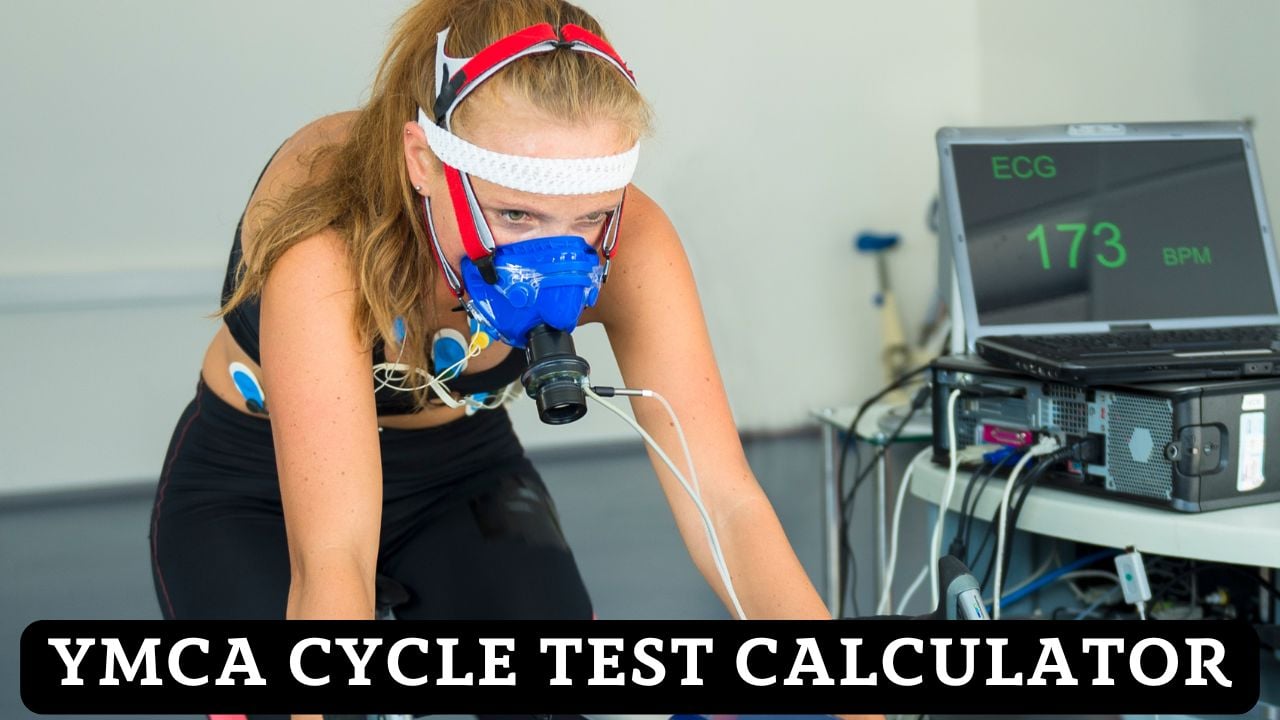🚴♂️ YMCA Cycle Test Calculator
Calculate your cardiovascular fitness level using the standardized YMCA Cycle Ergometer Test protocol

What is the YMCA Cycle Test?
The YMCA Cycle Test is a safe and effective way to measure your cardiovascular fitness without pushing yourself to exhaustion. Unlike other fitness tests that require maximum effort, this test uses your heart rate response to moderate cycling to predict your VO2 max – the gold standard measure of cardiovascular fitness. Regular fitness testing helps track your progress and motivate your fitness journey.
💓 How It Works
The test involves cycling at two different intensities for 3 minutes each while monitoring your heart rate. Your heart rate response to these workloads allows us to predict how much oxygen your body can use during maximum exercise (VO2 max). The beauty of this test is that it’s submaximal – you never have to push yourself to dangerous limits. Building leg strength can help improve your cycling performance and test results.
📊 Why VO2 Max Matters
VO2 max is like your body’s engine size – it tells you how efficiently your heart, lungs, and muscles work together during exercise. A higher VO2 max means better cardiovascular health, improved endurance, and reduced risk of heart disease. The YMCA test provides an accurate estimate of your VO2 max without expensive lab equipment or exhausting maximum effort tests. Combining cardio with strength training can help improve your overall fitness and VO2 max scores.
Understand Your Results
| Age Group | Men – VO2 Max (ml/kg/min) | Women – VO2 Max (ml/kg/min) | Fitness Level | Health Benefits |
|---|---|---|---|---|
| 20-29 years | 52+ (Excellent) 42-51 (Good) 33-41 (Average) |
44+ (Excellent) 34-43 (Good) 28-33 (Average) |
Peak fitness years | Optimal heart health, high energy |
| 30-39 years | 48+ (Excellent) 39-47 (Good) 30-38 (Average) |
40+ (Excellent) 31-39 (Good) 25-30 (Average) |
Maintaining fitness | Reduced disease risk, better metabolism |
| 40-49 years | 44+ (Excellent) 35-43 (Good) 27-34 (Average) |
36+ (Excellent) 28-35 (Good) 22-27 (Average) |
Fighting age decline | Slower aging, maintained strength |
| 50-59 years | 40+ (Excellent) 32-39 (Good) 24-31 (Average) |
32+ (Excellent) 25-31 (Good) 20-24 (Average) |
Active aging | Independence, disease prevention |
| 60+ years | 36+ (Excellent) 28-35 (Good) 22-27 (Average) |
30+ (Excellent) 23-29 (Good) 17-22 (Average) |
Healthy aging | Mobility, cognitive health |
What This Means: Higher VO2 max values indicate better cardiovascular fitness. Even small improvements can significantly impact your health and daily energy levels. Full-body strength training combined with cardio exercise can help improve your VO2 max over time.
How to Take the YMCA Cycle Test
Warm-Up (5 minutes)
Start with light cycling at 50 RPM (revolutions per minute) with minimal resistance. This prepares your muscles and cardiovascular system for the test.
Stage 1 (3 minutes)
Cycle at 150 watts (or 900 kg·m/min) while maintaining 50 RPM. Monitor your heart rate during the final minute. Your heart rate should be between 110-150 bpm.
Stage 2 (3 minutes)
Increase the workload based on your Stage 1 heart rate:
- If HR1 was under 120 bpm: Use 300 watts (1800 kg·m/min)
- If HR1 was 120-130 bpm: Use 250 watts (1500 kg·m/min)
- If HR1 was over 130 bpm: Use 200 watts (1200 kg·m/min)
Cool Down (5 minutes)
Gradually reduce intensity and continue light cycling to help your heart rate return to normal safely.
Equipment You’ll Need
🚴♂️ Cycle Ergometer
A stationary bike that allows precise workload control in watts or kg·m/min. Many gym-quality bikes have this feature. Learn about different gym equipment to find the right bike for your test.
💓 Heart Rate Monitor
A chest strap or wrist-based heart rate monitor for accurate readings. Chest straps are generally more accurate during exercise. Home workout alternatives can also help improve cardiovascular fitness.
⏱️ Timer
A stopwatch or timer to track the 3-minute stages accurately. Many fitness apps include interval timers perfect for this test.
📝 Recording Sheet
Paper or digital method to record your heart rates and workloads. Our calculator makes this easy by storing your results automatically.
Improving Your VO2 Max
🏃♂️ Cardiovascular Training
Regular aerobic exercise is the best way to improve your VO2 max. Aim for 150 minutes of moderate-intensity or 75 minutes of vigorous-intensity exercise per week. Activities like running, cycling, swimming, and rowing are excellent choices. Leg strengthening exercises can also support your cardiovascular training by building the muscles used in cycling and running.
⚡ High-Intensity Interval Training (HIIT)
HIIT workouts can significantly improve VO2 max in less time than steady-state cardio. Try alternating between high-intensity bursts (85-95% max heart rate) and recovery periods. Even 20-30 minutes of HIIT twice per week can lead to substantial improvements. Upper body strength training can complement your cardio routine for balanced fitness.
🏋️♀️ Strength Training
While cardio directly improves VO2 max, strength training supports cardiovascular fitness by improving muscle efficiency and reducing fatigue. Focus on compound movements that work multiple muscle groups. Arm strengthening exercises can improve your cycling performance and overall fitness test results.
Common Questions About the YMCA Cycle Test
❓ Is the YMCA Cycle Test accurate?
The YMCA Cycle Test has been scientifically validated and shows 85-90% accuracy compared to laboratory VO2 max testing for most individuals.
However, accuracy depends on several factors:
Most Accurate For: Moderately fit individuals with normal cardiovascular responses
Less Accurate For: Elite athletes, individuals with unusual heart rate responses, or those with cardiovascular conditions
Physiological Limits: Results above 90 ml/kg/min are extremely rare and may indicate measurement errors or need professional verification.
The test assumes linear heart rate response, which may not hold at very high fitness levels.
❓ Who should NOT take this test?
Avoid this test if you have uncontrolled high blood pressure, recent heart problems, severe arthritis, or any condition that makes moderate exercise unsafe. Always consult with a healthcare provider before starting any new fitness assessment, especially if you have existing health conditions or take medications that affect heart rate.
❓ How often should I retest?
Retest every 6-12 weeks to track your fitness improvements. VO2 max can improve significantly with consistent training, so regular testing helps monitor your progress and adjust your workout routine. Proper recovery between training sessions is essential for continued improvement.
❓ What affects my test results?
Several factors can influence your results: hydration level, recent food intake, caffeine consumption, stress, sleep quality, and medications. For the most accurate results, avoid caffeine 3-4 hours before testing, stay well-hydrated, and ensure you’re well-rested. Body composition also plays a role in cardiovascular fitness and test performance.
❓ Can I use a regular exercise bike?
You need a bike that can measure and control workload in watts or kg·m/min. Most home exercise bikes don’t have this precision, but many gym bikes do. Look for bikes with “watt mode” or “constant power” settings. Different gym machines can also help you build the leg strength needed for better cycling performance.
Building a Complete Fitness Program
🎯 Setting Realistic Goals
Use your YMCA test results as a baseline to set achievable fitness goals. Aim to improve your VO2 max by 10-15% over 3-6 months with consistent training. Focus on gradual progression rather than dramatic changes. Core strengthening provides a solid foundation for all cardiovascular activities.
📅 Weekly Training Schedule
A balanced program includes 3-4 days of cardiovascular exercise, 2-3 days of strength training, and 1-2 rest days. Vary your cardio activities to prevent boredom and overuse injuries. Home chest workouts and back exercises can be done on non-gym days to maintain your strength training routine.
🍎 Nutrition and Lifestyle
Proper nutrition supports your cardiovascular fitness improvements. Focus on whole foods, adequate protein, and staying hydrated. Quality sleep (7-9 hours) and stress management are equally important for fitness gains. Understanding body composition helps you make informed decisions about nutrition and training.
⚕️ Important Safety Information
This YMCA Cycle Test calculator provides estimates based on established scientific protocols and should not replace professional medical advice or supervised fitness testing. Individual results may vary based on factors including genetics, health conditions, medications, and testing conditions. The test assumes normal cardiovascular function and may not be accurate for individuals with heart conditions, blood pressure medications, or other health issues affecting heart rate response. Always consult with healthcare professionals or certified fitness professionals before beginning any new exercise program or fitness assessment, especially if you have pre-existing health conditions, are over 40, or have been sedentary. Stop the test immediately if you experience chest pain, dizziness, shortness of breath, or any unusual symptoms. This calculator is for educational and general fitness purposes only.
References
- Beekley MD, Brechue WF, deHoyos DV, Garzarella L, Werber-Zion G, Pollock ML. Cross-validation of the YMCA submaximal cycle ergometer test to predict VO2max. Res Q Exerc Sport. 2004 Sep;75(3):337-42. doi: 10.1080/02701367.2004.10609165. PMID: 15487296.
- Garatachea, Nuria & Cavalcanti, Euclides & García-López, David & González-Gallego, Javier & de paz, jose antonio. (2007). Estimation of Energy Expenditure in Healthy Adults From the YMCA Submaximal Cycle Ergometer Test. Evaluation & the health professions. 30. 138-49. 10.1177/0163278707300628.

Manish is a NASM-certified fitness and nutrition coach with over 10 years of experience in weight lifting and fat loss fitness coaching. He specializes in gym-based training and has a lot of knowledge about exercise, lifting technique, biomechanics, and more.
Through “Fit Life Regime,” he generously shares the insights he’s gained over a decade in the field. His goal is to equip others with the knowledge to start their own fitness journey.
